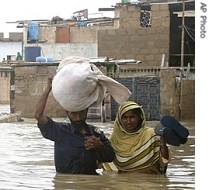-
(单词翻译:双击或拖选)
New Delhi
18 August 2007
International aid agency Oxfam says poorly built flood defenses in South Asia may have aggravated1 the intensity2 of the recent flooding in the region. It calls for a reassessment of flood policies in the region, where nearly 20 million people have been affected3 by flooding. Anjana Pasricha has a report from New Delhi.
 |
| A Pakistani family make their way through a flooded street after a heavy rain on 10 Aug. 2007 in Karachi, Pakistan |
Ian Bray4 of Oxfam has traveled through flood-hit areas in the Indian state of Bihar. He says many embankments are 50 years old, and are easily breached5.
"We witness huge breaks in the embankments. What happens is about a 12-foot wall of water probably 300 meters wide that breaks through the embankments and inundates6 anything in its way," he said.
The report estimates that in Bihar, embankments may have tripled the area prone7 to floods to about seven million hectares from two and a half million hectares. It says in Bangladesh, 75 embankments were breached in one month during this year's floods. And in Nepal culverts and embankments triggered major floods by obstructing8 the flow of water.
Experts say breached embankments not only contribute to massive flooding, they can be more destructive because they prevent water from draining away from flooded land.
Oxfam says governments must build good drainage systems to reduce the risk of floods.
Oxfam also urges South Asian governments to build more flood-proof infrastructure9 such as shelters on higher ground, and homes and wells on raised land to ease the miseries10 that flooding inflicts11 on communities.
Other aid agencies agree that flood preparedness needs to improve.
ActionAid India's emergency adviser12, P.V. Unnikrishnan, says governments need to spend more to prepare for floods, which have become an annual occurrence.
"If you make an investment of $1 in disaster preparedness and disaster risk reduction, it is thousand times more cost effective than reactionary13 responses which happen after the disaster," he noted14. "Invest in early warning systems and early response mechanisms15 and most importantly, develop plans by engaging the local communities."
This year's floods were the most intense in recent times. Tens of thousands have lost their homes and livelihoods16, and thousands of acres of farmland have been destroyed in some of the poorest regions of South Asia.
 收听单词发音
收听单词发音
1
aggravated

|
|
| 使恶化( aggravate的过去式和过去分词 ); 使更严重; 激怒; 使恼火 | |
参考例句: |
|
|
|
2
intensity

|
|
| n.强烈,剧烈;强度;烈度 | |
参考例句: |
|
|
|
3
affected

|
|
| adj.不自然的,假装的 | |
参考例句: |
|
|
|
4
bray

|
|
| n.驴叫声, 喇叭声;v.驴叫 | |
参考例句: |
|
|
|
5
breached

|
|
| 攻破( breach的现在分词 ); 破坏,违反 | |
参考例句: |
|
|
|
6
inundates

|
|
| v.淹没( inundate的第三人称单数 );(洪水般地)涌来;充满;给予或交予(太多事物)使难以应付 | |
参考例句: |
|
|
|
7
prone

|
|
| adj.(to)易于…的,很可能…的;俯卧的 | |
参考例句: |
|
|
|
8
obstructing

|
|
| 阻塞( obstruct的现在分词 ); 堵塞; 阻碍; 阻止 | |
参考例句: |
|
|
|
9
infrastructure

|
|
| n.下部构造,下部组织,基础结构,基础设施 | |
参考例句: |
|
|
|
10
miseries

|
|
| n.痛苦( misery的名词复数 );痛苦的事;穷困;常发牢骚的人 | |
参考例句: |
|
|
|
11
inflicts

|
|
| 把…强加给,使承受,遭受( inflict的第三人称单数 ) | |
参考例句: |
|
|
|
12
adviser

|
|
| n.劝告者,顾问 | |
参考例句: |
|
|
|
13
reactionary

|
|
| n.反动者,反动主义者;adj.反动的,反动主义的,反对改革的 | |
参考例句: |
|
|
|
14
noted

|
|
| adj.著名的,知名的 | |
参考例句: |
|
|
|
15
mechanisms

|
|
| n.机械( mechanism的名词复数 );机械装置;[生物学] 机制;机械作用 | |
参考例句: |
|
|
|
16
livelihoods

|
|
| 生计,谋生之道( livelihood的名词复数 ) | |
参考例句: |
|
|
|















